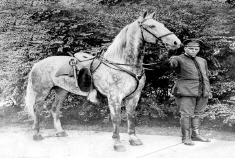
The other week, Nic Harrison talked about “fixin' to get ready” with the momentous task of transforming DWP. So what does getting ready mean? For me, it means two things:
- Stopping all the horseholding we do
- Learning how to leapfrog.
Horseholding
 Horseholding is hanging onto things that are standing in the way of transformation. It’s the sort of stuff that new joiners notice before they start to conform, and the sort of stuff that long servers know is meaningless and non-value add but have given up trying to battle with.
Horseholding is hanging onto things that are standing in the way of transformation. It’s the sort of stuff that new joiners notice before they start to conform, and the sort of stuff that long servers know is meaningless and non-value add but have given up trying to battle with.
The word comes from a story about soldiers in the Second World War who stood to attention before a gun was fired thus holding up the actual firing process. When asked why they did this it took a long-retired Colonel to remember that in the days when guns were drawn by horses the soldiers had to hold the horses as the gun was fired to stop them bolting when they heard the noise. Seventy years later the standing to attention was still an unquestioned representation of this.
I’ve noticed a few DWP horseholdings
For example, I got a great email the other day. The first paragraph read ‘DWP has been asked to seek expressions of interest for around 20 facilitators …. Grade is not critical.’ The next paragraph read ‘If you are interested in this excellent development opportunity please send your details including your name, grade, job role’. Hmmm, grade isn’t critical but please tell us what yours is...? Is ‘grade’ one of the things we’re horseholding? Others are layers of governance, hard-copy documents, bureaucratic processes (dare I say the performance management system?), the language of command and control – ‘commissions’, ‘what’s the exam question?’, ‘Who’s marking the homework?’ and acting in functional areas not across the Department.
Leapfrogging
Leapfrogging is what we have to do now. Think of telecoms in many African countries. They’ve gone straight into mobile phones, mobile banking, and other mobile technologies never having had fixed landlines. We have to look similarly at where we can effectively leapfrog. Right now, for example, as we design DWP for 2020 we are moving from doing small scale redesigns to meet specific programme needs, towards digitalising services, new ways of working including Smarter Working, and creating new(ish) delivery models. But this is not enough. To get to transformation we have to leapfrog that middle ground and go for fundamentally restructuring in a way that radically changes our Departmental shape, size, operating model and partner relationships.
One lovely, albeit small, experiment we could build on this is running at Loxley House, Nottingham. I had the chance to visit and see a leapfrog in action – an integrated team made up of local authority and DWP employees, managed by a DWP team leader, working in a local authority building (the building is open 24/7), delivering a professional service that secures jobs for local unemployed people.
The many practical challenges they faced have been overcome by having a clear, shared goal and a collaborative/non-hierarchical working style.
Being even bolder we could imagine no DWP but a tiny Civil Service that is just a Secretariat, or a Civil Service which is only a policy maker or one that is entirely ‘e-enabled’. (Look at Estonia for a current leader in this field).
Leapfrogging takes nerve and energy and it can be scary. It is also exciting, challenging and (I think) absolutely essential. To really transform we have to give up horse-holding and start to leapfrog.
Think of your horseholding examples and let me know what they are.
Now consider where the leapfrog opportunities are and let me know on those too.
